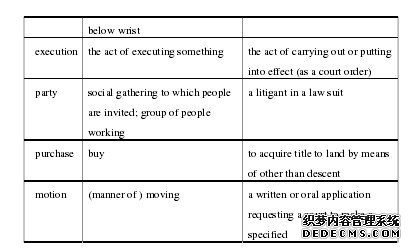Chapter I Text Analysis
1. Features of the Source Text
Crime Scene Investigation, Criminalistics, and the Law is about crime sceneinvestigation and criminalistics, and the laws that govern them. It falls to the category ofexposition. The major difference between exposition and other writing styles is its uniquefeatures: clarity, fluency and logic. Therefore, the source text inherited these traits fromexposition; in the meantime, it also has the features of legal text. English legal terms havetheir own characteristic features no matter whether in grammar, vocabulary, semantics, orin logic. Therefore, all these elements should be taken into account in translation.
…………
2. Expected Functions of the Target Text
According to Vermeer’s text typology theory, the original text belongs to the type ofcontent-focused text which shows “dominant interest in conveying certain matters, dataor information” (Vermeer, 2004: 25) and is “characterized as concerned primarily if notexclusively with communicating information” (Vermeer, 2004: 30). Based on this, theexpected functions of the translation text of Crime Scene Investigation, Criminalistics,and the Law are:First of all, this book gives information and provides vital tool for anyone whoworks in investigation, analysis, reporting, prosecution, or defense of criminal law.Therefore, its communicative and informative function cannot be ignored.Secondly, it should be understandable to the readers. The target text can be read bystudents and in-service personnel in criminal justice, as well as all those readers who justwant to know more about the fascinating topics of crime scene investigation,criminalistics, and the law. Therefore, an accurate translation is crucial for the readers.
……………
ChapterⅡ Process Description
1. Pre-task Preparation
Instead of hastily translation of the original text, the author collected a large amountof information about the writer and his related work at first, to get a preliminaryunderstanding of a host of knowledge including the writer’s life experience, writingbackground and style. After that, author read the book from cover to cover in order tograsp the overall language style of original text.Then, intensive reading is spent on the chapters which were chosen to translate, andall the legal terms and long sentences were marked with different color. More than that,adhering to “better tools make for good work”, the dictionary and reference-book wereused to help realize consistent terminology such as criminalistics(刑事侦查学),criminology(犯罪学), Exhibits(当庭出示证件、物证等), trace evidence(微量迹证),andso on, so that common mistakes can be avoid, and it’s friendly for proofreading inpost-editing stage.
……………
2. The Delivery Period
According to Marianne Lederer, one of the representatives of French oralinterpretation theory of sense, “the delivery period is the most important in the process oforal translation.” (La traduction aujourd’hui: le modèle interprétatif, Paris, HachetteLivre S.A., 1994) Translation is actually a restatement, in target language, of the originalmeaning in source language. The task of the translator is to seek the greatest languageand cultural relevance between the original and target language. It means to convey themeaning of the original work in the target language, which can make the reads get theinformation that is in the source language. However, the translation is inevitablyrestricted by the culture embodied in both languages. Therefore, some difficulties stillexist during the translation, and this part will be discussed in Chapter Three. The last stage is correcting and editing stage. The translated Chinese version wassent immediately after it is finished, to one of the author’s friends who is major in law to check the logical error in professional views, then instructed by the supervisor for furtheradvice and suggestions; at last, corrected by the author for several times.
…………..
ChapterⅡProcess Description ...........3
1. Pre-task Preparation........ 3
2. The Delivery Period........ 3
3. Posting-Editing ........... 3
ChapterⅢ Case Analysis ...........5
1. Word Processing ......... 5
2. Long Sentences.........7
3. Interrogative Sentences ........ 10
4. Passive Voice ........ 11
ChapterⅢ Case Analysis
1. Word Processing
The difference between English and Chinese embodies in many aspects: theclassification of word class, sentence development and language expression. However,the purpose of translation is the understanding of the source language information for thetarget language reader’s; therefore, the literal translation is not good enough to conveymeaning effectively. In the meantime, as a professional field of language, legal languageis characterized by the precision and seriousness of its lexical aspect. According to thisprinciple, the author adopted such strategies as omission and amplification in theprocessing of words. One of the important differences between legal English and general English is thatcommon words have special legal meanings which are different from the meanings incommon English. These legal terms create the wide gap between legal Englishvocabulary and common English vocabulary. The author picked out some wordsencountered during the translation, making a clear comparison of the common meaningof common words with their legal sense in the language of law.

…………..
Conclusion
As an important tool to combine the linguistics and culture, legal language helpspeople all around the world get to know each other’s legal culture, and plays animportant role in strengthening mutual communications among different countries. In thisrespect, the status of legal translation determines which translations can be used inspecific situations in legal communications.So far, the author has discussed the main features of legal English. It can be seenclearly that the language features of English legal text are mainly shown in four aspects:lexicon, long sentence and wide use of interrogative sentence and passive voice. On theaspect of lexicon, the author emphasized the importance of the common words with legalmeanings, and adopted strategies, for example, omission and amplification, to reach abetter translation. Coping with long sentences in source text, the author tried to start withtwo sides: translating in the original order, and in chronological and logical order.Besides, the widely adoption of declarative sentences and passive voice is anotherimportant factor which should be taken into consideration during the translation. Thus, inorder to make a successful translation, the translator should not only be skillful at thelanguage of both source and target texts, but also have a good knowledge in legal field.In the process of translation, the author has learned a lot from this practiceexperience and tried to apply the translation theories and strategies to practices. In themeantime, some experience has been gained from this practice.
…………
Reference (omitted)
